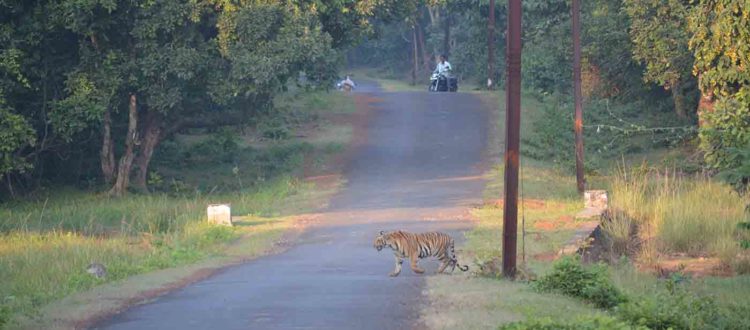On The Amelioration Brink
“Look! Five tigers together!” exclaimed Sakil when we suddenly came upon them, a tigress and her four sub-adult cubs, on the road. We stopped the RRT vehicle on the silent road between Ekara and Mendki. It must have been just after 9 pm on 17th March 2019 when we were returning from an amelioration meeting, one of the community outreach activities we conduct in the Vidarbha landscape to sensitise people on tigers.
The tigress moved away from our vehicle but the curious cubs decided to move closer to explore, settling down right in front of us barely a few meters away! My survey assistants Sakil and Kishore saw a tiger for the first time ever and were mesmerized and thrilled on seeing five tigers at a time. We sat there silently, looking at the tigers for a good fifteen minutes when I remembered I had a camera with me and photographed this rare instance.
By now another car had approached from behind us and having also seen the tigers, it slowed down as one of the passengers took his phone camera out to record. As the car came abreast, I warned this person against having his hand out of the open window. Just as they overtook our vehicle, the tiger which was standing in front of our vehicle jumped suddenly and chased after them. Had the man not withdrawn his hand in in the nick of time, he surely would have gotten injured! I managed to click some photographs before the young tiger backed off and sat on the road again. Despite of being warned, it is unfortunate that people take such huge risks while being ‘adventurous’. Had this person been injured, the blame would have fallen on this wild animal.
[acx_slideshow name=”tiger”]
Although I have seen tigers a number of times, this experience was extraordinary as one rarely sees five full grown tigers outside the protected areas. I had known these four cubs and their mother since a year and half. I encountered them on 18th October 2018 on the same road when their mother had made a cattle kill near Ekara lake. The tiger family had wanted to cross the road after drinking from Ekara Lake near the forest guest house just 500 m away from the Ekara village. I saw that some villagers from Ekara voluntarily stood guard on the road to give safe passage to the animals. They stood casually so people in vehicles were not made aware of the presence of tigers and if someone noticed, the villagers politely explained the risks of lingering too long and didn’t let vehicles stop in the area. Eventually the cubs safely crossed the road. It was happy moment for me as I have experienced fierce aggression of people for the big cat during our initial work in this landscape but after the many consultative and amelioration meetings with villagers, the people’s perception towards the animal is beginning to change.
In a bid to engage relevant authorities and local people to seek their support in mitigating human wildlife conflict in the Navegaon Tadoba corridor, we had organized a series of 32 amelioration meetings in high conflict villages of Bramhapuri division in consultation with Mr. Kulraj Singh (DCF, Bramhapuri) during 2018-19. These meetings created a significant positive impact on people’s perception of the human wildlife conflict, in Bramhapuri division. The villagers readily support the FD staff so they may conduct of their routine work during the human wildlife cases without any hindrances.
The occurrence of human wildlife conflict in this landscape can primarily be attributed to the ever increasing anthropogenic stress on the forests surrounding the villages. People are dependent on forests for collection of Non Timber Forest Produce (NTFP’s) and for grazing their cattle. In some instances, large carnivores such as tigers and leopards are drawn closer to human settlements as they follow their prey such as deer and wild boar which are in turn attracted by seasonal crops in agricultural fields.
The incident I narrated above could also have turned into human wildlife conflict! Perhaps if people understood the importance of maintaining a distance from wild animals in an unprotected forest area and instead enjoyed safaris in protected areas and tiger reserves, such instances may reduce.
One of the cubs, a young female, from this tiger family was chemically captured by Forest Department (FD) as she was attributed to having caused three human deaths in a span of one and a half months. The other three cubs and their mother continue to lead their life in the forest while our team continues to spread awareness amongst villagers regarding the safety measures they must follow while venturing into the forest.
I still marvel at being lucky enough to have witnessed these five majestic tigers sitting on the road that night and wish that my future generations and that of the tigresses are just as lucky.
The author of the article, Mahendra Bhojram Raut currently works as Field Officer in Integrated Tiger Habitat Conservation Programme in the Tadoba Navegaon Corridor. Mahendra works on wildlife crime prevention, environment education and amelioration meetings to reduce human-wildlife conflict in Brahmapuri forest division of Chandrapur district. He also trains Biodiversity Management Committees (BMC’s) in Vidarbha region. He is keenly interested in birds, wetlands, forest and community.









